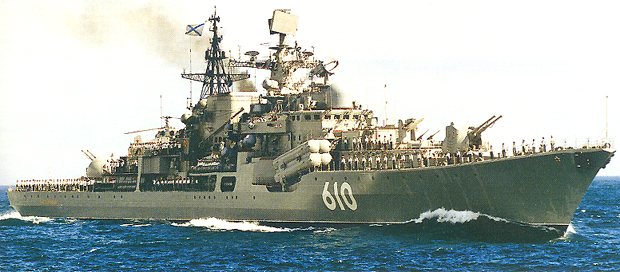
IVANOV COMMENT SUGGESTS MOSCOW IGNORING NUCLEAR WEAPONS AGREEMENT WITH WASHINGTON
Publication: Eurasia Daily Monitor Volume: 3 Issue: 168
By:

On Sunday September 10, during a meeting with Russian President Vladimir Putin aboard the Baltic Fleet’s flagship, the destroyer Nastoychivy, at the naval base Baltiysk, Kaliningrad, Defense Minister Sergei Ivanov made public that Russia has apparently abrogated a major nuclear arms control agreement. During the meeting, Ivanov reported to the president the successful test launch of two submarine-based ICBMs: one from the Pacific Ocean by nuclear sub Svyatoi Georgy Pobedonosets, the other from the North Pole by the Yekaterinburg nuclear sub. Both launches were aimed at a test range in Arkhangelsk region, and Ivanov reported that the ICBM warheads had successfully hit their targets (Interfax, September 10).
According to Ivanov, the launch from the North Pole area was the first of its kind in 11 years. It is clear that this test launch imitated an attack from U.S. territory and that the Russian Navy has resumed Cold War training exercises that were previously abandoned.
Then came the real sensation: Putin asked how many Russian nuclear subs were at sea. Ivanov reported: “Today, there are eight nuclear-powered submarines at sea on combat patrols. Five of them are strategic and three are multipurpose, but each of them has nuclear arms aboard” (Interfax, September 10). Ivanov made the statement and then repeated it once again unequivocally, as broadcast the same day by Russian government’s Rossiya television channel: “The subs have different tasks — some are armed with ICBMs, others are multipurpose — but each of them has nuclear weapons aboard.” Ivanov’s statement is highly significant, because under existing agreements it is illegal for Russia to deploy non-strategic nuclear weapons on board attack (multipurpose) subs.
On September 27, 1991, U.S. President George H.W. Bush announced drastic cuts in non-strategic (tactical) nuclear weapons and invited the Soviet Union to follow his lead. Ten days later Soviet President Mikhail Gorbachev agreed to do the same. In January 1992, after the collapse of the Soviet Union, Russian President Boris Yeltsin officially committed Russia to continue tactical nuclear disarmament.
The non-strategic arms limitation agreements required the total destruction of all nuclear artillery shells, tactical land-based missile warheads, and nuclear land mines. They also mandated the partial destruction of anti-missile and anti-aircraft defense missile warheads, non-strategic naval nuclear weapons, and Air Force and Naval Air Force bombs. All the nuclear weapons left after the partial destruction and, in particular, all non-strategic naval weapons were to be detached from delivery systems, taken off ships and subs, and placed in centralized storage facilities away from naval and other military bases. The only exceptions were Air Force tactical bombs that were allowed to be deployed at storage facilities near air bases (Carnegie Endowment for International Peace, Nuclear Status Report, www.ceip.org).
Great Britain later joined Russia and the United States in removing non-strategic nuclear weapons from ships and subs. All cuts of tactical nukes were to be completed by the end of 2000, and only strategic ICBM warheads could be deployed at sea. On April 25, 2000, Russian Foreign Minister Igor Ivanov (now secretary of the Russian Security Council) told the Non-Proliferation Treaty Review Conference in New York that Russia had “practically completed cuts” in compliance with its nuclear non-strategic obligations.
The tactical nuclear limitation agreements are not a formal treaty, and no compliance verification mechanism ever existed. Despite statements to the contrary, questions about Russian compliance with non-strategic nuclear disarmament have been raised. Unlike U.S. naval-based, long-range cruise missiles, their Russian (Soviet) equivalents — the Granat and Granit — were not designed or ever tested to carry conventional warheads. Still Russian attack subs continued to deploy these missiles at sea, which did not make sense if only their nuclear tips continued to be in place despite official pledges.
However, now the time for speculation is over. Ivanov’s statement, made in front of reporters and President Putin reveals unequivocally that Russian attack subs are being deployed “on combat patrols” against NATO ships with battle-ready non-strategic nukes onboard. Russia is clearly cheating now and may have been cheating on its signed tactical nuclear arms control promises all along.
Ivanov’s de facto abrogation of the non-strategic arms limitation agreement comes at a time when military-to-military relations with the West are at an all time low. Last week prearranged peacekeeping and anti-terrorist military exercises that were scheduled to take place this month in Nizhny Novgorod oblast (U.S.-Russian) and Pskov oblast (NATO-Russian) were suddenly cancelled. Ivanov’s announcement of the battlefield redeployment of non-strategic nukes was hardly a simple slip of the tongue. As the incumbent regime in Russia is preparing for parliamentary elections next year and presidential ones in 2008, anti-NATO and anti-American rhetoric is being supplemented by official anti-Western military actions.
The collapse of the existing tactical nuclear limitation regime is not in Russia’s national interests, since the United States and Great Britain have the capability to deploy tens of times more naval nuclear long-range cruise missiles and other non-strategic nukes than does Russia. But it would seem that the Kremlin is still ready to risk drastically worsening relations. Increased military tension may facilitate a nationalistic anti-U.S., anti-NATO surge of public opinion in Russia that might help carry someone like Ivanov (or whomever Putin chooses) into the Kremlin as the new president.




